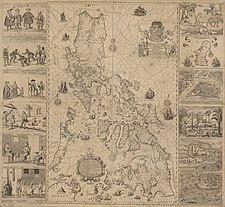Our website is made possible by displaying online advertisements to our visitors.
Please consider supporting us by disabling your ad blocker.
Tondo (historical polity)
Tondo Tundun[1] | |||||||||||
|---|---|---|---|---|---|---|---|---|---|---|---|
| before 900[2][Notes 1]–1589[3] | |||||||||||
 Location of Tondo (colored red) in 1570. | |||||||||||
| Capital | Tondo | ||||||||||
| Common languages | Old Tagalog, Kapampangan, and Classical Malay[2] | ||||||||||
| Religion | |||||||||||
| Government | Bayan ruled by a lakan, consisting of several barangay duchies that are ruled by the respective datu[9][5][10][11] | ||||||||||
| Lakan | |||||||||||
• c. 900 | Jayadewa, the Senapati of Tundun and Lord Minister of Pailah (according to a record of debt acquittance) | ||||||||||
• 1450–1500[citation needed] | Gat Lontok and Dayang Kalangitan | ||||||||||
• Late 15th century-1521 | Malangsi[12] | ||||||||||
• 1521–1575[citation needed] | Lakandula | ||||||||||
• 1575–1589[citation needed] | Agustin de Legazpi | ||||||||||
| Historical era | Antiquity to Early modern[2][Notes 3] | ||||||||||
• First historical mention, in the Laguna Copperplate Inscription; trade relations with the Mataram Kingdom implied[2] | before 900[2][Notes 1] | ||||||||||
• Various proposed dates for the founding of the neighboring Rajahnate of Maynila range as early as the 1200s (see Battle of Manila (1258) and (1365)) to the 1500s (see Battle of Manila (1500))[Notes 4] | c. 1200s to c. 1500s | ||||||||||
• Establishment of regular trade relations with the Ming dynasty[13] | 1373 | ||||||||||
• Territorial conflict with Maynila during the reign of Rajah Matanda's mother[5] | c. 1520 | ||||||||||
| 1570 | |||||||||||
| 1571 | |||||||||||
• Attack of Limahong and concurrent Tagalog revolt of 1574 | 1574 | ||||||||||
• Discovery of the Tondo Conspiracy, dissolution of indigenous rule, and integration into the Spanish East Indies | 1589[3] | ||||||||||
| Currency | Piloncitos, Gold rings, and Barter[15] | ||||||||||
| |||||||||||
| Today part of | Philippines | ||||||||||
| History of the Philippines |
|---|
 |
| Timeline |
|
|
Tondo (Tagalog: [tunˈdo]; Baybayin: , Kapampangan: Balayan ning Tundo), erroneously referred to as the Kingdom of Tondo, was a Tagalog settlement which served as a major trade hub located on the northern part of the Pasig River delta on Luzon Island. Together with Maynila, the polity (bayan) that was also situated on the southern part of the Pasig River delta, Tondo had established a shared monopoly on the trade of Chinese goods throughout the rest of the Philippine archipelago, making it an established force in trade throughout Southeast Asia and East Asia.[7][16][9]
Tondo is of particular interest to Filipino historians and historiographers because it is one of the oldest historically documented settlements in the Philippines. Scholars generally agree that it was mentioned in the Laguna Copperplate Inscription, the Philippines' oldest extant locally produced written document, dating back to 900 A.D.[2][9][17]
Following contact with the Spanish beginning in 1570 and the defeat of local rulers in the Manila Bay area in 1571, Tondo was ruled from Intramuros, a Spanish fort built on the remains of the Maynila polity. Tondo's absorption into the Spanish Empire effectively ended its status as an independent political entity; it now exists as a district of the modern City of Manila.
- ^ Postma, Antoon (April–June 1992). "The Laguna Copper-Plate Inscription: Text and Commentary". Philippine Studies. Ateneo de Manila University. 40 (2): 182–203. JSTOR 42633308.
- ^ a b c d e Postma, Antoon (June 27, 2008). "The Laguna Copper-Plate Inscription: Text and Commentary". Philippine Studies. 40 (2). Ateneo de Manila University: 182–203. Archived from the original on December 8, 2015. Retrieved January 31, 2017.
- ^ Cite error: The named reference
Corpuz1989was invoked but never defined (see the help page). - ^ a b Cite error: The named reference
SoulBook1991was invoked but never defined (see the help page). - ^ a b c d Cite error: The named reference
Scott1994was invoked but never defined (see the help page). - ^ a b Osborne, Milton (2004). Southeast Asia: An Introductory History (Ninth ed.). Australia: Allen & Unwin. ISBN 1-74114-448-5.
- ^ a b c Jocano, F. Landa (2001). Filipino Prehistory: Rediscovering Precolonial Heritage. Quezon City: Punlad Research House, Inc. ISBN 971-622-006-5.
- ^ Maggay, Melba Padilla (1999). Filipino Religious Consciousness. Quezon City: Institute for Studies in Asian Church and Culture. ISBN 971-8743-07-3.
- ^ a b c "Pre-colonial Manila". Malacañang Presidential Museum and Library. Malacañang Presidential Museum and Library Araw ng Maynila Briefers. Presidential Communications Development and Strategic Planning Office. June 23, 2015. Archived from the original on March 9, 2016. Retrieved April 27, 2017.
- ^ Rafael, Vicente L. (2005) The Promise of the Foreign: Nationalism and the Technics of Translation in the Spanish Philippines.
- ^ Ming Annals (Chinese (archived from the original on April 11, 2008)
- ^ Cite error: The named reference
:1was invoked but never defined (see the help page). - ^ Scott, William Henry (1989). "Societies in Prehispanic Philippines". Prehispanic Source Materials for the Study of Philippine History. Quezon City: New Day Publishers. ISBN 978-971-10-0226-8.
- ^ Joaquin, Nick (1990). Manila, My Manila. Vera Reyes, Inc. pp. 18–20.
- ^ Ocampo, Ambeth R. (August 30, 2011). "'Piloncitos' and the 'Philippine golden age'". opinion.inquirer.net. Archived from the original on May 16, 2017. Retrieved April 28, 2017.
- ^ Abinales, Patricio N.; Amoroso, Donna J. (2005). "Maryland: Rowman and Littlefield". State and Society in the Philippines. Archived from the original on July 24, 2015.
- ^ Cite error: The named reference
Scott1984was invoked but never defined (see the help page).
Cite error: There are <ref group=Notes> tags on this page, but the references will not show without a {{reflist|group=Notes}} template (see the help page).
Previous Page Next Page


